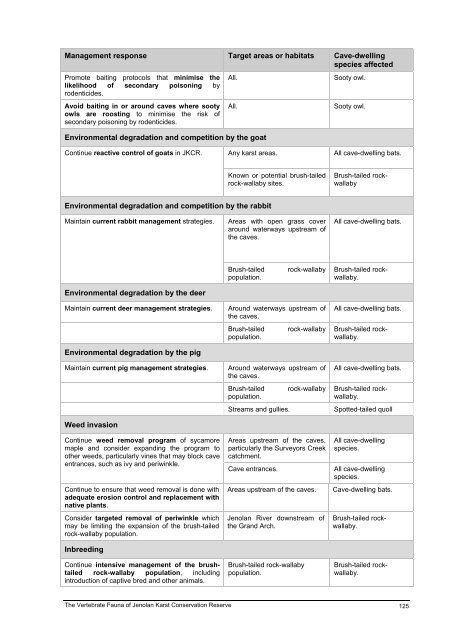The Vertebrate Fauna of Jenolan Karst Conservation Reserve: Final
The Vertebrate Fauna of Jenolan Karst Conservation Reserve: Final
The Vertebrate Fauna of Jenolan Karst Conservation Reserve: Final
You also want an ePaper? Increase the reach of your titles
YUMPU automatically turns print PDFs into web optimized ePapers that Google loves.
Management response Target areas or habitats Cave-dwelling<br />
species affected<br />
Promote baiting protocols that minimise the<br />
likelihood <strong>of</strong> secondary poisoning by<br />
rodenticides.<br />
Avoid baiting in or around caves where sooty<br />
owls are roosting to minimise the risk <strong>of</strong><br />
secondary poisoning by rodenticides.<br />
Environmental degradation and competition by the goat<br />
Continue reactive control <strong>of</strong> goats in JKCR.<br />
Environmental degradation and competition by the rabbit<br />
Maintain current rabbit management strategies.<br />
Environmental degradation by the deer<br />
All. Sooty owl.<br />
All. Sooty owl.<br />
Any karst areas. All cave-dwelling bats.<br />
Known or potential brush-tailed<br />
rock-wallaby sites.<br />
Areas with open grass cover<br />
around waterways upstream <strong>of</strong><br />
the caves.<br />
Brush-tailed rock-wallaby<br />
population.<br />
Maintain current deer management strategies. Around waterways upstream <strong>of</strong><br />
the caves.<br />
Environmental degradation by the pig<br />
Brush-tailed rock-wallaby<br />
population.<br />
Maintain current pig management strategies. Around waterways upstream <strong>of</strong><br />
the caves.<br />
Weed invasion<br />
Continue weed removal program <strong>of</strong> sycamore<br />
maple and consider expanding the program to<br />
other weeds, particularly vines that may block cave<br />
entrances, such as ivy and periwinkle.<br />
Continue to ensure that weed removal is done with<br />
adequate erosion control and replacement with<br />
native plants.<br />
Consider targeted removal <strong>of</strong> periwinkle which<br />
may be limiting the expansion <strong>of</strong> the brush-tailed<br />
rock-wallaby population.<br />
Inbreeding<br />
Continue intensive management <strong>of</strong> the brushtailed<br />
rock-wallaby population, including<br />
introduction <strong>of</strong> captive bred and other animals.<br />
Brush-tailed rock-wallaby<br />
population.<br />
Brush-tailed rockwallaby<br />
All cave-dwelling bats.<br />
Brush-tailed rockwallaby.<br />
All cave-dwelling bats.<br />
Brush-tailed rockwallaby.<br />
All cave-dwelling bats.<br />
Brush-tailed rockwallaby.<br />
Streams and gullies. Spotted-tailed quoll<br />
Areas upstream <strong>of</strong> the caves,<br />
particularly the Surveyors Creek<br />
catchment.<br />
All cave-dwelling<br />
species.<br />
Cave entrances. All cave-dwelling<br />
species.<br />
Areas upstream <strong>of</strong> the caves. Cave-dwelling bats.<br />
<strong>Jenolan</strong> River downstream <strong>of</strong><br />
the Grand Arch.<br />
Brush-tailed rock-wallaby<br />
population.<br />
Brush-tailed rockwallaby.<br />
Brush-tailed rockwallaby.<br />
<strong>The</strong> <strong>Vertebrate</strong> <strong>Fauna</strong> <strong>of</strong> <strong>Jenolan</strong> <strong>Karst</strong> <strong>Conservation</strong> <strong>Reserve</strong> 125

















